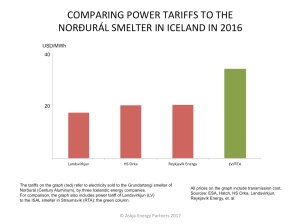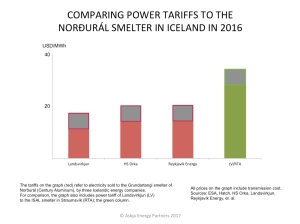Power tariffs to the Century smelter at Grundartangi
The Norðurál smelter of Century Aluminum, at Grundartangi in Southwest Iceland, enjoys the lowest electricity tariff to aluminum smelters in Iceland. The only company in Iceland paying lower electricity tariff, is the ferrosilicon plant of Elkem, also located at Grundartangi.
 All the three largest power companies in Iceland supply the Grundartangi aluminum smelter with electricity. The pricing arrangements in all the contracts are quite similar. All the contracts have the power tariff aligned to the price of aluminum on the London Metal Exchange (LME). In 2016, all the three power companies selling electricity to the Norðurál smelter where receiving an average price close to 20 USD/MWh (as shown on the graph at left). Note that transmission cost is included in the price shown on this graph.
All the three largest power companies in Iceland supply the Grundartangi aluminum smelter with electricity. The pricing arrangements in all the contracts are quite similar. All the contracts have the power tariff aligned to the price of aluminum on the London Metal Exchange (LME). In 2016, all the three power companies selling electricity to the Norðurál smelter where receiving an average price close to 20 USD/MWh (as shown on the graph at left). Note that transmission cost is included in the price shown on this graph.
For comparison, the graph also shows the power price from Landsvirkjun (LV) to the ÍSAL smelter of Rio Tinto Alcan (RTA) at Straumsvík in Southwestern Iceland. Of all the three aluminum smelters in Iceland, the Straumsvík smelter pays the highest electricity tariff. Which is not surprising, as the Straumsvík smelter has the most recent power contract. More information about recent power contracts with aluminum smelters can be seen here.
Most of the power consumed by the Norðurál smelter is generated by Reykjavík Energy, utilizing geothermal sources (unfortunately Reykjavík Energy has been faced with major difficulties in sustaining its geothermal power production). Reykjavík Energy is called Orka náttúrunnar (ON) in Icelandic. It is a subsidiary of Orkuveita Reykjavíkur (OR), which is mostly owned by the city of Reykjavík.
The second largest power supplier to the Norðurál smelter is the national power company Landsvirkjun. Landsvirkjun generates most of its electricity in hydropower stations. In 2016, the company concluded a new agreement with Norðurál/Century, which will change the pricing method (the new agreement goes into force in 2019).
The third company selling power to the Norðurál smelter is the privately owned HS Orka, where Canadian Alterra Power is the major shareholder. Like Reykjavík Energy, HS Orka mostly relies on geothermal sources for its power generation.
 As mentioned above, the cost of transmission is included in the power prices on the graph above. Each of the three power companies has to pay the transmission cost forward to the Icelandic Transmission System Operator (TSO), which is Landsnet. The graph at left should make it more clear what amount (price) the power companies are receiving for each megawatt-hour (MWh) of electricity sold. On this graph, we highlight the part of the tariff that is the transmission cost (the grey part of the columns). Finally, note that readers should presume a confidence interval (uncertainty limits) of 5% regarding the Landsvirkjun-tariffs presented, and a 10% confidence interval regarding tariffs from Reykjavík Energy and HS Orka.
As mentioned above, the cost of transmission is included in the power prices on the graph above. Each of the three power companies has to pay the transmission cost forward to the Icelandic Transmission System Operator (TSO), which is Landsnet. The graph at left should make it more clear what amount (price) the power companies are receiving for each megawatt-hour (MWh) of electricity sold. On this graph, we highlight the part of the tariff that is the transmission cost (the grey part of the columns). Finally, note that readers should presume a confidence interval (uncertainty limits) of 5% regarding the Landsvirkjun-tariffs presented, and a 10% confidence interval regarding tariffs from Reykjavík Energy and HS Orka.




